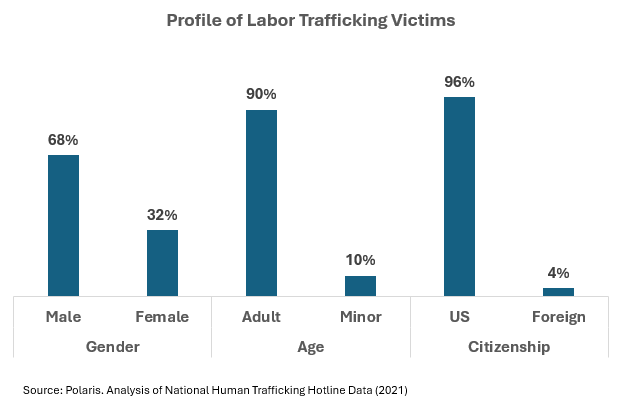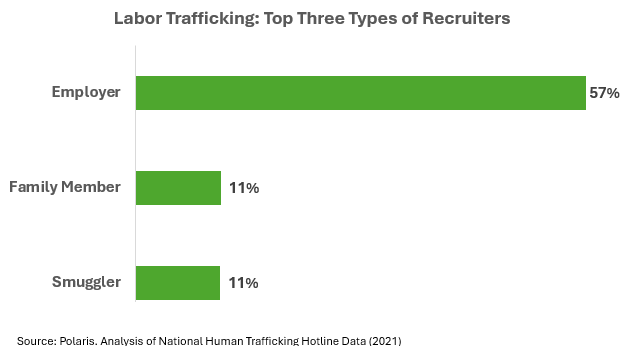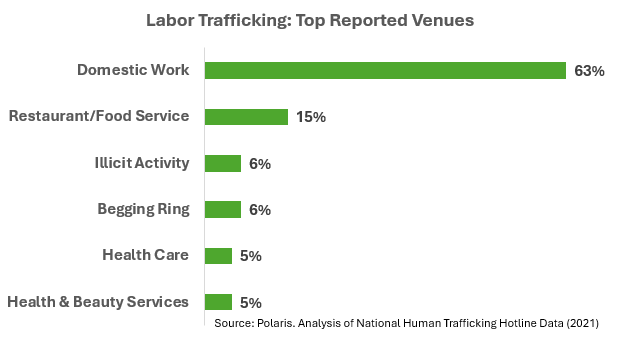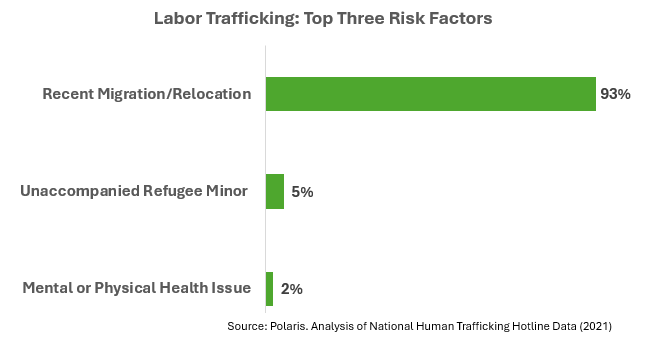Labor Trafficking in California: Patterns & Profiles
Following our recent examination of sex trafficking, this week we analyze pure labor trafficking in California through the lens of data and demographics. This form of modern slavery, while less visible in media coverage, makes up approximately 30% of human trafficking cases in our state and follows distinct, identifiable patterns.
It occurs across diverse sectors - from restaurants and private homes to beauty spas and organized begging rings - where traffickers exploit vulnerable workers through force, fraud, or coercion.
________________
Clear Patterns Emerge
Labor trafficking reveals a demographic profile strikingly different from sex trafficking. Unlike sex trafficking, where victims are predominantly female and include many minors, labor trafficking data shows a distinct pattern: 68% of victims are male, 90% are adults, and an overwhelming 96% are foreign citizens.
This predominance of adult male victims challenges common trafficking stereotypes about who can be trafficked.
Data also reveals a clear racial pattern among victims: 80% are Hispanic and 11% Asian, while other races including White and Black make up the remaining 9%.
________________
Industry Patterns and Recruitment Networks
The data paints a clear picture of how trafficking networks operate. Employer-recruiters dominate the landscape, accounting for 57% of cases, while family members and smugglers each represent 11% of recruiters.
Social media platforms, particularly Facebook, have become primary recruitment tools, with 72% of traffickers using online channels to lure victims through false promises of legitimate employment.
________________
Domestic work and the restaurant industry are key trafficking sectors, with victims commonly working in private homes and back-of-house restaurant positions. These industries enable exploitation through cash-based transactions, limited oversight, and informal practices, with victims facing excessive hours and/or wage theft.
________________
Vulnerabilities
When examining what makes individuals vulnerable to labor trafficking, the data shows a striking pattern. Recent immigration status is by far the predominant risk factor in labor trafficking cases at 93%, with unaccompanied refugee minors representing another 5% of victims
Traffickers frequently exploit victims' immigration status, using threats related to deportation as powerful leverage to maintain control and prevent victims from seeking help.
________________
Progress in Enforcement and Support
California has increased its commitment to combating human trafficking through significant investment and coordinated action. Since 2019, the state has invested $280.1 million in enforcement efforts and survivor support programs, including the expansion of Family Justice Centers throughout the state.
Operation Reclaim and Rebuild, one of the state's signature enforcement initiatives, conducts coordinated actions annually. Two recent examples demonstrate its impact:
The 2020 operation achieved significant results:
Recovered 87 victims, including 11 minors
Made 518 total arrests
The 2024 operation continued this work:
Led to 29 trafficking-related arrests
Provided support services to 23 victims
These enforcement efforts are complemented by an expanding network of support services, exemplified by the recent opening of a new Family Justice Center in the city of Danville, based in Contra Costa County, in late 2024.
________________
Moving Forward
Labor trafficking remains a form of modern slavery that demands constant vigilance and dedicated action. While California has made progress through state investment, coordinated enforcement operations, and strong nonprofit partnerships, traffickers continue to exploit vulnerable populations. The challenge ahead requires sustained commitment to monitoring areas with vulnerable populations, disrupting online recruitment networks, and strengthening victim support services.






